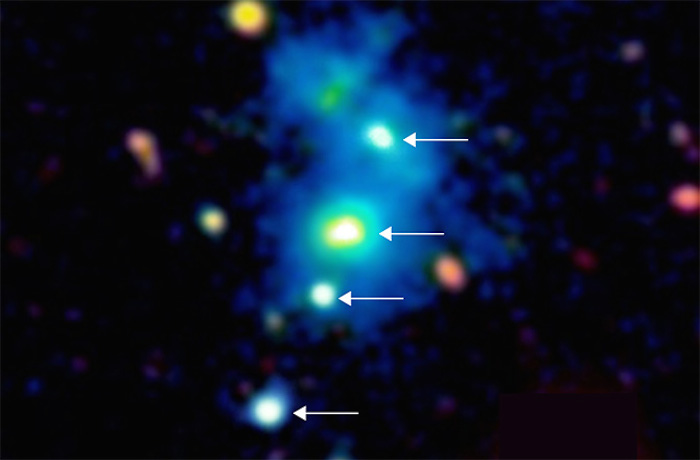.

Image of the region of the space occupied by the rare quasar quartet. The four quasars are indicated by arrows. The quasars are embedded in a giant nebula of cool dense gas visible in the image as a blue haze. The nebula has an extent of one million lightyears across, and these objects are so distant that their light has taken nearly 10 billion years to reach telescopes on Earth. This false color image is based on observations with the Keck 10m telescope on the summit of Maunakea in Hawaii.
.
Astronomers have found a quartet of quasars embedded in a single cloud of cold gas, a discovery that challenges currently held theories about how these rare objects form.
This was a big week for space! Astronomers found both the oldest star we've ever seen, and also the youngest galaxy. Trace is here to tell you what these two findings can teach us about the origins of everything!
ESO
“The discovery is significant both because there are four of them, and because they are so close together,” lead researcher Joseph Hennawi, with the Max Planck Institute for Astronomy in Germany, told Discovery News.
Astronomers are lucky to catch a glimpse of a single quasar, which appear for a tiny sliver of time at the peak of a supermassive black hole’s feeding frenzy.
The influx of material into a galaxy’s central black hole – areas where gravity is so strong that not even photons of light can escape -- doesn’t last long, but the turmoil causes the region around the black hole to shine hundreds of times brighter than its host galaxy, becoming the most luminous objects in the universe.
Quasars are typically solitary beasts, separated by hundreds of millions of light years. About 100 have been found in pairs. Only two sets of triplets have been discovered, and now, a single quartet.
“This was extremely surprising, as we knew that quasars are very rare objects, and it should be extremely unlikely to find four of them so close together,” Hennawi wrote in an email.
The newly found foursome are within 650,000 light years of one another, which is equivalent to about 25 percent of the distance between Milky Way and its nearest big neighbor galaxy Andromeda, he added.
The odds that the discovery is a chance encounter are one in 10 million, Hennawi said, raising the prospect that quasars are more likely to occur in specific environments than current models predict.
The quadruple quasar, for example, is embedded in a single dense cloud of cold hydrogen gas. It also is located in a massive proto-cluster of galaxies.
“It may be that quasar episodes are more likely to be triggered in such an unusual environment, which is rich in both gas and galaxies” – conditions that were thought to be mutually exclusive, Hennawi said.
“Current models of how structure forms in the universe would never predict that there would be so much cool, dense gas around. Instead, those models predict that the gas in such a massive object should be 1,000 times hotter and 1,000 times less dense,” he said.
The discovery offers a unique opportunity to glimpse the assembly of the most massive structures in the universe, added astronomer Michele Fumagalli, with Durham University in the United Kingdom.
“With this study, we are taking a ride back in time -- roughly 10 billion years ago -- and get to see how massive clusters are made,” said Fumagalli, who was with the team that discovered a triple quasar in 2013.
The quasar quartet also provides insight into how black holes may grow over time, she added.
The research, which is based on observations by the W.M. Keck observatory in Hawaii, is published in this week’s Science.
Quelle:D-News
5000 Views
